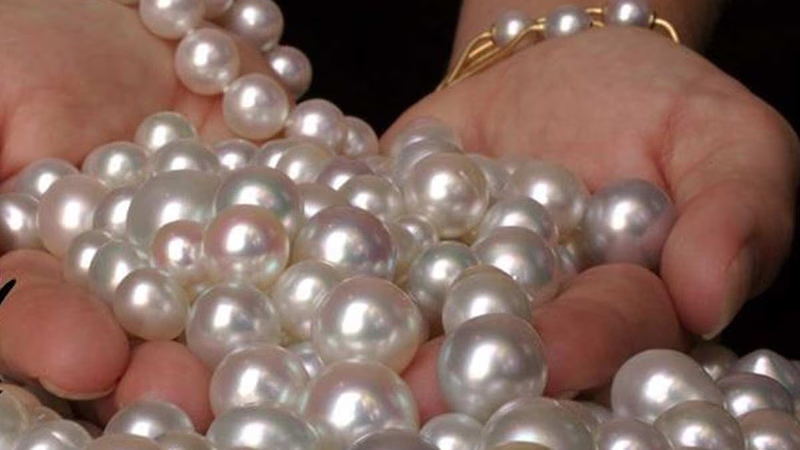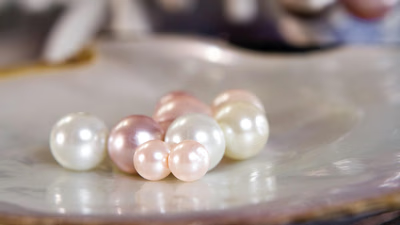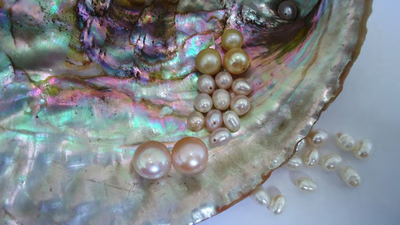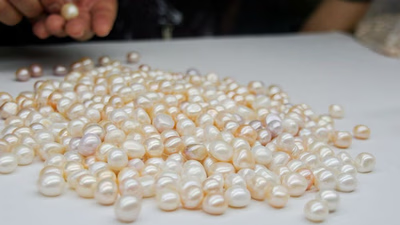
Diverse pearl types showcasing beauty in trade markets.
Pearl farmers employ various techniques to culture pearls, resulting in different types. Different methods of nucleation, implantation, and farming conditions can influence the shape, size, and quality of the resulting pearls. For instance, freshwater pearls are cultivated in freshwater environments, while saltwater pearls are produced in marine environments. Different species of mollusks produce pearls with distinct characteristics. For example, Akoya pearls are primarily produced by the Pinctada fucata oyster, while South Sea pearls come from the Pinctada maxima oyster. Each species has its unique traits, such as size, luster, and color, resulting in a variety of pearl types.
Akoya pearls are known for their classic beauty and are primarily cultivated in Japan and China. They are typically small to medium in size, ranging from 2 to 10 millimeters. Akoya pearls have a high luster and are most commonly white or cream-colored, with overtones of rose, silver, or cream. South Sea pearls are cultured primarily in countries such as Australia, Indonesia, and the Philippines. They are among the largest pearls available, ranging from 10 to 20 millimeters in size. South Sea pearls are admired for their luxurious luster, often in shades of white, cream, or golden.
In general, we have two types of pearls: natural and cultured. The meaning of natural pearl is a pearl that is formed in the heart of nature and as a result of the accidental entry of stimulating factors into the oyster body. When a stimulus enters the body of a pearl-forming mollusk, the host organism secretes a substance to fight, which eventually leads to the formation of pearls. But in pearls grown in farms, the stimulus for the formation of pearls is manually entered into the shell, and the birth of pearls is no longer accidental.
Mabe pearls, also known as blister pearls, are cultivated by attaching a half-spherical nucleus to the inside of the mollusk's shell. As a result, they have a flat back and a domed front. Mabe pearls can be found in various shapes and colors and are commonly used in earrings, pendants, and rings. Conch pearls are rare and unique pearls found in the large marine mollusks known as queen conch. They are mainly sourced from the Caribbean Sea and are admired for their vibrant colors, including shades of pink, orange, and red. Conch pearls are highly sought after by collectors and jewelry enthusiasts.
Natural and cultured pearls can be divided into two categories: saltwater and freshwater. Saltwater pearls take longer to form. Although salt water has a better shine and higher quality, it is slightly less durable and more expensive. But freshwater pearls are formed in a shorter period of time and are more abundant and more expensive, but they are not as bright as saltwater pearls and are usually smaller. Almost all types of pearls, both saltwater and freshwater, available in the market are cultured.
The structure of cultured pearls depends on the type of pearl that is placed inside the oyster as the primary nucleus. Another way to distinguish pearls from each other is that cultured pearls are yellow under ultraviolet light and green under X-ray light. Pearls are produced in various types, shapes and sizes and are divided into 4 categories based on the place of growth (with salt or fresh water) and the type of shell in which they are placed, each of which has a special beauty and charm. have their own Next, we describe the characteristics of each type.
Tahitian pearls, also known as black pearls, are cultivated in French Polynesia, particularly around the islands of Tahiti. They are renowned for their dark hues, which range from black to gray, peacock green, blue, and other exotic colors. Tahitian pearls are highly sought after for their unique beauty and large sizes. Freshwater pearls are cultivated in freshwater environments, such as lakes and rivers, primarily in China. They are typically irregular in shape and vary in size from small to medium. Freshwater pearls are available in a wide range of colors, including white, pink, lavender, and various pastel shades. They are often more affordable than other types of pearls.
The environment in which the mollusks live or are cultured impacts the growth and appearance of pearls. Factors such as water quality, temperature, salinity, and nutrient availability can affect the formation process, resulting in characteristic differences among pearl types. For example, Tahitian pearls develop their distinctive dark colors due to the unique conditions in the waters around Tahiti. Genetic factors can also contribute to variations in pearls. Just as individual humans have unique traits, mollusks within the same species can exhibit genetic variation, resulting in differences in pearl characteristics.
-

Natural pearl fishing in the Persian Gulf has a storied history, particularly around Bahrain, known for its rich oyster beds. Skilled divers employed traditional techniques to harvest oysters, facing dangers like drowning and shark attacks. This labor-intensive process involved extracting and grading pearls for local markets and international trade, significantly contributing to the region"s economy and cultural heritage. However, the rise of cultured pearls in the early 20th century, coupled with overfishing and environmental changes, led to a decline in natural pearl demand. Historically significant areas for pearl diving included "Mughas" or "Mughas al-Lulu
-

Pearls are categorized based on their cultivation methods, environments, and the mollusks that produce them. The two main types are natural and cultured pearls, with further distinctions between saltwater and freshwater varieties. Saltwater pearls, such as Akoya and South Sea pearls, are known for their high luster and larger sizes, while freshwater pearls are more abundant and come in various colors but typically have a lower shine. Akoya pearls, primarily from Japan and China, range from 2 to 10 millimeters in size and are often white or cream-colored. South Sea pearls, sourced from Australia and the Philippines, can be as large as 20 millimeters and exhibit luxurious luster in shades of white or gold. Mabe pearls have a unique shape due to their cultivation method involving a half-spherical nucleus. Conch pearls are rare gems known for their vibrant colors found in queen conch mollusks. Environmental factors like water quality and temperature significantly influence pearl characteristics, leading to variations in size, shape, and color among different types.
Tahitian pearls stand out for their dark hues cultivated in French Polynesia. Overall, the pearl industry is shaped by both natural processes and human intervention through farming techniques.
-

The Persian Gulf, particularly around Bahrain, has a rich history of producing some of the world"s finest natural pearls, known for their luster and unique colors. South Sea pearls from Australia, Indonesia, and the Philippines are also highly valued for their size and creamy hues. The Gulf of Mannar between India and Sri Lanka is recognized for its high-quality pearls with warm tones. Historically, the Persian Gulf"s pearl industry thrived until the early 1930s when oil discoveries shifted focus to more profitable ventures. This led to overfishing and pollution that devastated the pearl industry. Today, pearl oyster beds remain in the Persian Gulf, especially near Bahrain, where fishing has occurred for over two millennia. Despite other countries like Japan and Australia producing notable pearls, the Persian Gulf"s natural pearls are still considered among the best due to their unique environmental conditions. However, the legacy of traditional pearl diving has been largely overshadowed by industrial changes in the region. "
-

Natural pearls form organically within mollusks without human intervention, resulting from irritants like sand. They are rare and valued for their unique characteristics. Cultured pearls, on the other hand, are created through human intervention by implanting a nucleus into the mollusk, leading to nacre secretion. While they closely resemble natural pearls in appearance and are more affordable, distinguishing between the two can be challenging. Specific weight is one method of differentiation, with natural pearls typically weighing less than 2. 73. Cultured pearls exhibit luminescence under UV light, while artificial pearls are man-made from materials like glass or plastic and lack the organic qualities of natural or cultured varieties. The rise of artificial pearl production in China has significantly impacted the natural pearl industry in regions like the Persian Gulf. Understanding these differences is crucial for consumers and traders in the pearl market.
-

The price of pearls is influenced by several key factors including type, size, shape, luster, color, surface quality, and origin. Natural pearls and rare varieties like conch or Tahitian pearls are more valuable due to their scarcity. Larger pearls are generally more expensive, with significant price increases for larger sizes. Round pearls are the most sought after for their symmetry, while other shapes like baroque are less valuable. Luster plays a crucial role; pearls with high luster reflect light better and command higher prices. Freshwater pearls are typically less expensive than Akoya or Tahitian varieties. The South Sea pearl is the most expensive type, with prices ranging from $1,000 to over $100,000 based on size and quality. The origin of the pearl also affects its value; those from renowned regions like the Persian Gulf or South Sea are often priced higher due to their reputation.
Market demand and trends can further influence prices as consumer preferences shift. Overall, the value of a pearl is determined by a combination of these factors.
-

Natural pearls are gemstones formed within mollusks, such as oysters and mussels, when an irritant becomes trapped in their soft tissue. The mollusk secretes layers of nacre around the irritant, resulting in a pearl over several years. Factors like the species of mollusk and environmental conditions influence the pearl"s shape, luster, and color. Historically valued for their beauty, pearls have been traded for thousands of years, particularly in regions like China. They can vary in color from white to blackish gray and come in various shapes, with round pearls being the most sought after. The size of pearls typically ranges from 7 to 9. 5 mm, with larger and smoother specimens commanding higher prices. While natural pearls are rare and highly valued in jewelry, most pearls on the market today are cultured, created through human intervention to initiate pearl formation.
Cultured pearls resemble natural ones but are more affordable and widely available. "






